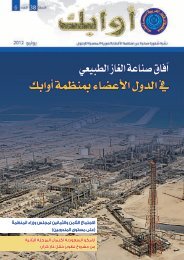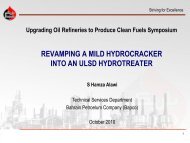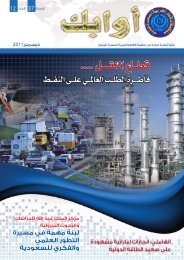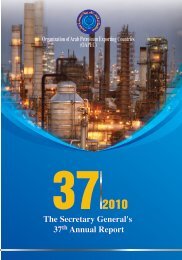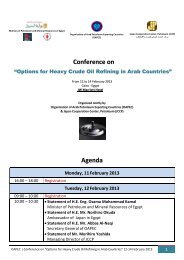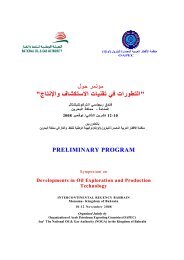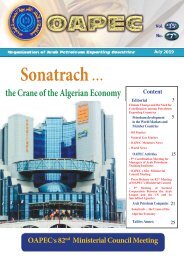chapter two - OAPEC
chapter two - OAPEC
chapter two - OAPEC
You also want an ePaper? Increase the reach of your titles
YUMPU automatically turns print PDFs into web optimized ePapers that Google loves.
• Organization of Petroleum Exporting countries' efforts played a key role<br />
in restoring balance and stability in the oil market, as the significant<br />
reduction in production carried out by OPEC from the beginning of<br />
January 2009 was a decisive factor behind the downward trend in prices<br />
since the beginning of the year. The continued application of OPEC’s<br />
reduction throughout the year helped reducing the surplus in supply in oil<br />
market.<br />
• International determination to confront the crisis and the actions taken by<br />
some countries towards stimulate their economies had a positive reflection<br />
on oil demand. At the same time, it contributed in spreading the spirit of<br />
optimism that the worst of the crisis had ended in a faster pace than<br />
expected.<br />
• The confidence generated by both producing and consuming countries<br />
alike on the need to stabilize prices at a level higher than it was in the<br />
beginning of the year to ensure the necessary investments for the oil<br />
industry on the one hand, and not adversely affect world economic growth<br />
on the other.<br />
• The impact of U.S. dollar devaluation against other major prices, in light<br />
of the inverse relationship between oil prices and the dollar exchange rate,<br />
especially in recent years with the difference in the degree of change.<br />
• Speculations and investments played a key role in raising oil prices to<br />
levels difficult to interpret within the framework of market fundamentals,<br />
as the daily rates rose to levels more than $ 77/b for OPEC basket, and<br />
more than $ 8 /b for U.S. light crude.<br />
It is noteworthy, since the beginning of the year, the flow of liquidity<br />
to oil markets increased for different reasons, including storing oil in large<br />
tankers on the high seas waiting for higher prices, and hedging of the weak<br />
dollar and low return on investment in other assets.<br />
Year 2009 also saw significant developments in the pattern of price<br />
differentials, where the differentials between light sweet crudes and heavy<br />
sour crudes reduced to unusual levels compared with previous years. For<br />
example, the differential between Dubai crude (representing the heavy<br />
crudes) and U.S. light sweet crude reached around $0.1/b only in 2009<br />
compared with $5.8/b in the previous year. The price of Dubai was $0.2/b<br />
above Brent in 2009 while it was lower by $3.2/b in 2008. The same applies<br />
for the price of OPEC basket, which was $0.9/b lower than the price of U.S.<br />
light sweet crude in 2009 compared to $5.2/b higher in the previous year.<br />
The price of OPEC basket also $0.6/b lower than the price of Brent crude in<br />
2009 compared with $2.6 / b higher in 2008.<br />
Those developments in price differentials can be attributed to several<br />
factors, including:



